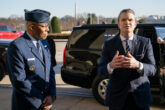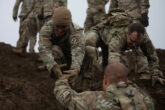May 27, 2014
Brimley: Slow But Steady in Afghanistan and Beyond
President Obama made the right call in deciding to maintain 9,800 U.S. troops in Afghanistan – a number close to that recommended by U.S. military commanders. Augmented by coalition forces, as well as a robust U.S. intelligence, diplomatic, and development footprint, it should serve as a means to facilitate the continued growth of Afghanistan’s security forces and prevent a rapid erosion of security gains that a more dramatic “zero option” would surely have precipitated.
But the President also signaled his intent to halve the number of troops by the end of 2015 and then transition to a small presence at the U.S. Embassy in Kabul by the end of 2016. Such a rapid transition is probably unrealistic given the enormous challenges Afghanistan is facing. The consequences of getting the final details of the drawdown wrong are enormous, given the potential impacts within South Asia but also around the world – an obvious point given the geographic source of the attacks on September 11, 2001.
It is quite likely that the President’s advisors also believe the rapid drawdown in 2015 and 2016 is unlikely to materialize exactly as envisioned given the realities on the ground today in Afghanistan. So why did the President articulate the plans for 2015 and 2016 in such detail? There are probably two reasons the President chose to convey a more ambitious drawdown schedule.
First, the President’s team probably believes that conveying a more accelerated transition gives U.S. diplomats and military commanders some additional leverage over the coming year. Very hard negotiations over intelligence sharing, training, logistics, and military sales are occurring and will continue for some time. Conveying a sense that we believe the onus is on Afghan leaders to request extensions of assistance could be helpful. It is also possible that the U.S. country team in Afghanistan believes that a more ambitious drawdown schedule will give the new Afghan president (to be decided in a June 14 runoff) some more flexibility by not forcing him to resist a more substantial multi-year U.S. troop presence immediately upon taking office.
Second, it is important that President Obama convey to the American people a sense that this war, America’s longest, is finally coming to an end. President Obama understands very well the connection between the views of the American people and a sustainable U.S. national security policy. Any President who discounts this connection risks eroding what remains of a long-term foreign policy consensus built around an active and engaged U.S. military, working with allies and partners during times of peace but also conflict.
It is here where the President and his team have an important role to play, particularly during the U.S. mid-term elections and then the run-up to the 2016 presidential campaign. Recent polling suggests that the American people are extremely dubious regarding the role we play in shoring up the international order. According to a 2013 PEW Poll, for the first time since 1964, more than half of the U.S. public (52%) agree that the U.S. should “mind its own business internationally and let other countries get along the best they can on their own.” This profound sense of skepticism regarding the efficacy of U.S. national security policy will not dissipate without clear and consistent leadership from the President, his team, and the broader foreign policy community.
In this sense, correctly navigating the final phase of U.S. engagement with Afghanistan will be a powerful factor in strengthening political will behind a strong and steady U.S. leadership role around the world.
More from CNAS
-
Hegseth Brings the Culture War to Combat
The fundamental challenge of military leadership lies in creating cohesive teams that can work together in an environment of mortal risk and, when called upon to do so, use le...
By Dr. Jason Dempsey
-
Hegseth Says Trump Boosted Military Recruiting. It’s Been Improving for over a Year
Defense Secretary Pete Hegseth says military recruiting has shot up since the Trump administration's return. In fact, it's been improving for at least a year, with big jumps i...
By Taren Sylvester
-
Pete Hegseth’s Views About Women and Military Standards
In recent weeks, Hegseth walked back comments made while promoting his book, where he said women did not belong in ground combat units. Without citing specific examples, he co...
By Katherine L. Kuzminski
-
Sharper: Trump's First 100 Days
Donald Trump takes office in a complex and volatile global environment. Rising tensions with China, the continued war in Ukraine, and instability in the Middle East all pose s...
By Charles Horn




